BumpTop Brings Multi-Touch to The Computer Desktop

Share

Do you ever wish you could just reach out and move the icons on your computer desktop around the same way you do with pieces of paper on your physical desk? BumpTop has created a software system to allow you to do just that. Their version of a computer desktop has icons that appear as objects with weight and shapes that can be manipulated, letting their interaction seem much more intuitive to users. Today, BumpTop announced that it has taken the concept to the next level, and will provide multi-touch support for Windows 7 and MS touchscreen. CEO and Co-founder Anand Agarawala explains the original concept of BumpTop in a TED video after the break. Then, we have the multi-touch approach demo video right below.
So there's really two products here, the current BumpTop system which you can upload onto your PC right now via their website, and a future touchscreen enhanced version that will likely be released to coincide with the adoption of Windows 7. Both versions are trying to make files on your desktop more like real world objects, like so many other experimental human-computer interfaces we've discussed. The files can collide with one another, be stacked in piles, etc, just like pieces of paper. At the same time, you don't want to lose the benefits of digital files: easy sorting, changing relative size of object on desktop, etc. The trick is to make the digital space act like a physical space in some areas, but still have the digital utilities where you need them. In the TED video you'll notice that while Agarawala can use a mouse to throw files around like paper, he also can click to bring up menus that allow for sorting and other digital techniques. That sort of hybridization approach to human-computer interfaces is a powerful paradigm we are likely to see dominate the future of computing.
https://video.ted.com/assets/player/swf/EmbedPlayer.swf
If Agarawala's TED talk has you fired up to try the original (non-touchscreen) BumpTop, you'll be pleased to know that a free trial version is available on their site. The fully fledged professional version costs around $30, and can be downloaded from the same page. BumpTop is also hoping to expand its user base through bundled packaging. Since August, the desktop software has been included when you purchase certain 3D graphics cards from HIS, Powercolor, and Sapphire.
Be Part of the Future
Sign up to receive top stories about groundbreaking technologies and visionary thinkers from SingularityHub.


BumpTop's upcoming multi-touch approach, uses a set of defined gestures to control the way files are moved and changed. It's sort of a precursor to a manipulation-language. Just as we've learned to use 'ctrl', 'shift', and other keys on a keyboard we could learn new ways to position our hands and move our fingers to augment the way we control our new real-world inspired desktop.
While BumpTop may seek to patent or otherwise control that gesture language, I hope that some version of it becomes too universal to be restricted to a single platform. As we move to computers without keyboards or mice, we'll need a shared understanding of how to access digital processes through physical movements. BumpTop's 'scrunch' move to put files in a pile works well, as does the 'lasso' gesture, which accomplishes the same thing. However, the same scrunch movement could just as easily have been used to crumple, delete, or shrink a file. The lasso gesture is similar to a common editors mark for removing a line of text. Without a shared gesture language that everyone agrees upon and dynamically controls, a user will have to rethink their movements for every new platform. Hopefully BumpTop will cooperate rather than compete with other multi-touch developers to form that language.
Making the digital world resemble the physical world is a powerful technique that will only grow more useful as digital information is infused into objects all around us. We're entering a time when walls are becoming computer screens. As augmented reality takes off, intuitive interfaces are going to become a vital necessity to help users navigate their enhanced experience. Whether or not BumpTop becomes the model for such navigation, I'm confident that the human-computer interface of the future will be a fusion of the best parts of the physical and digital experience.
Related Articles

How Scientists Are Growing Computers From Human Brain Cells—and Why They Want to Keep Doing It

These Brain Implants Are Smaller Than Cells and Can Be Injected Into Veins

This Wireless Brain Implant Is Smaller Than a Grain of Salt
What we’re reading